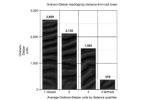Cancer in Vista del Monte Elementary School in Palm Springs with a Cell Tower on Campus
In February 2010, I received an E-mail from Kim McClinton, a science teacher at Vista del Monte elementary school in Palm Springs, California. She had heard about the La Quinta study and thought her school had the same problem. The school had a reputation for being a “cancer school” in the school district. Since 2005, there has been a cell phone tower located within a few feet of a classroom wing in the school courtyard.
During a visit to the school, I showed Kim how to use the G/ S meter, and she produced a color-coded analysis of G/ S readings by classroom. The entire school had very high dirty electricity readings. Their dirty electricity levels were higher than those at the La Quinta school. The Vista del Monte G/ S readings averaged 1,300 compared to 750 at La Quinta. The cancers (twelve cancers, including six female breast cancers among seventy-five personnel employed at the school since 1990) were over-represented in the wing of the school closest to the cell tower, and the G/ S readings were highest in the classrooms closest to the cell tower base. At the same stage of the investigation, La Quinta school had eleven cancers in 137 teachers. A fourth grade teacher complained that her students were hyperactive and un-teachable. The outlets in her room measured over 5,000 Graham/ Stetzer units. On a Friday afternoon after school, I reduced the measured dirty electricity in the wiring from over 5,000 to less than 50 Graham/ Stetzer units with five plug-in filters. With no change in either the cell tower radiation or the lighting, the teacher reported an immediate dramatic improvement in student behavior in the following week. They were calmer, paid more attention and were teachable all week except for Wednesday when they spent part of the day in the library. Later, the teacher told me that she could change the behavior of the children by removing and reinserting the filters. The change took between 30 and 45 minutes. This young teacher also became the thirteenth cancer case in this small teachers’ cohort. On January 25, 2011, I presented my findings to the Palm Springs Unified School District Board of Education. I sent the Powerpoint of my presentation in advance. I was surprised to learn at the last minute that the board had hired Leeka Kheifets to contest my findings and had provided her with a copy of my presentation. Of course, I had not been given a copy of her presentation. I offered to filter the school at no cost to the district, guaranteeing an improvement in student test scores and attendance. My offer was refused.
One teacher with poorly controlled type 2 diabetes, in spite of insulin injections and oral hypoglycemic medication, had repeated foot infections and a below-the-knee amputation. He retired in 2009, and his blood glucose readings have been normal since then. Magda Havas has shown that dirty electricity raises blood glucose levels and changes insulin requirement in diabetics. The blood glucose connection could be how dirty electricity increases cardiovascular disease incidence. The major mortality and morbidity in diabetics is due to acceleration of cardiovascular diseases. Magda Havas has also shown that radiation from DECT (Digital Enhanced Cordless Telecommunications) phones can cause an instant change in heart rate and rhythm in some exposed individuals. Cell tower transmitters, like most modern electrical equipment, operate on direct current. The electrical current brought to the tower is alternating current which needs to be changed to direct current. This is done by a switching power supply or an inverter. These devices interrupt the AC current and are the likely source of the dirty electricity in the wing of the school closest to the tower. That little device you plug into the wall to charge your cell phone is one of these. They are present in all computers, copy machines, and television sets. This is another serious but unrecognized hazard of cellular telephone technology. People who are concerned about health issues regarding cell towers focus on the RF emissions, but dirty electricity is another unrecognized important exposure. To illustrate just how far dirty electricity effects can extend, after Dave Stetzer filtered a Midwestern school, a dairy farmer a quarter of a mile away noticed that his cows each gave an average of ten pounds more milk per day beginning the day the school was filtered. The cows were responding to dirty electricity being removed from the ground currents.
Milham MD MPH, Samuel (2012-12-06). Dirty Electricity: Electrification and the Diseases of Civilization (pp. 81-82). iUniverse. Kindle Edition.




